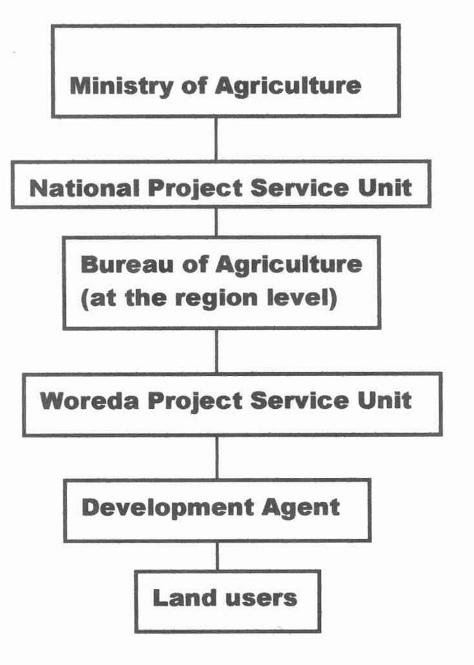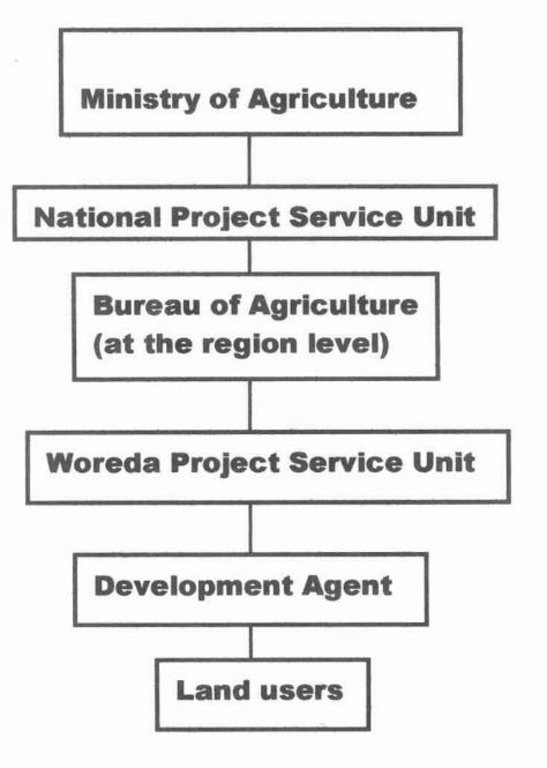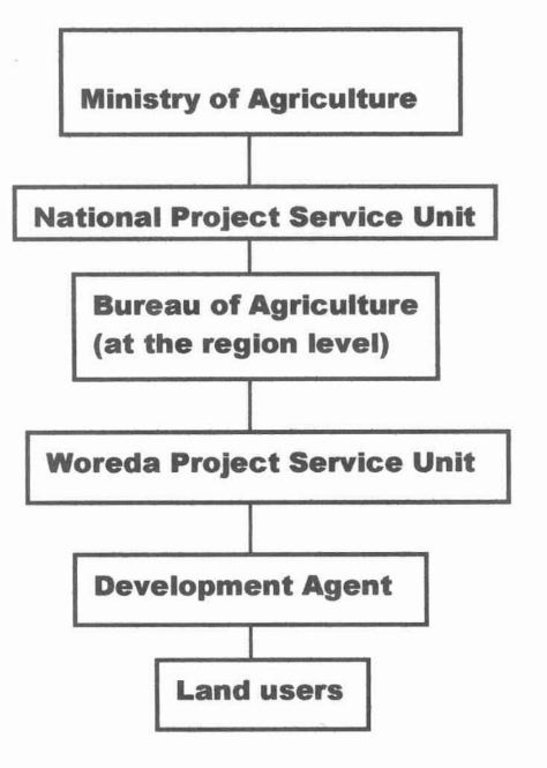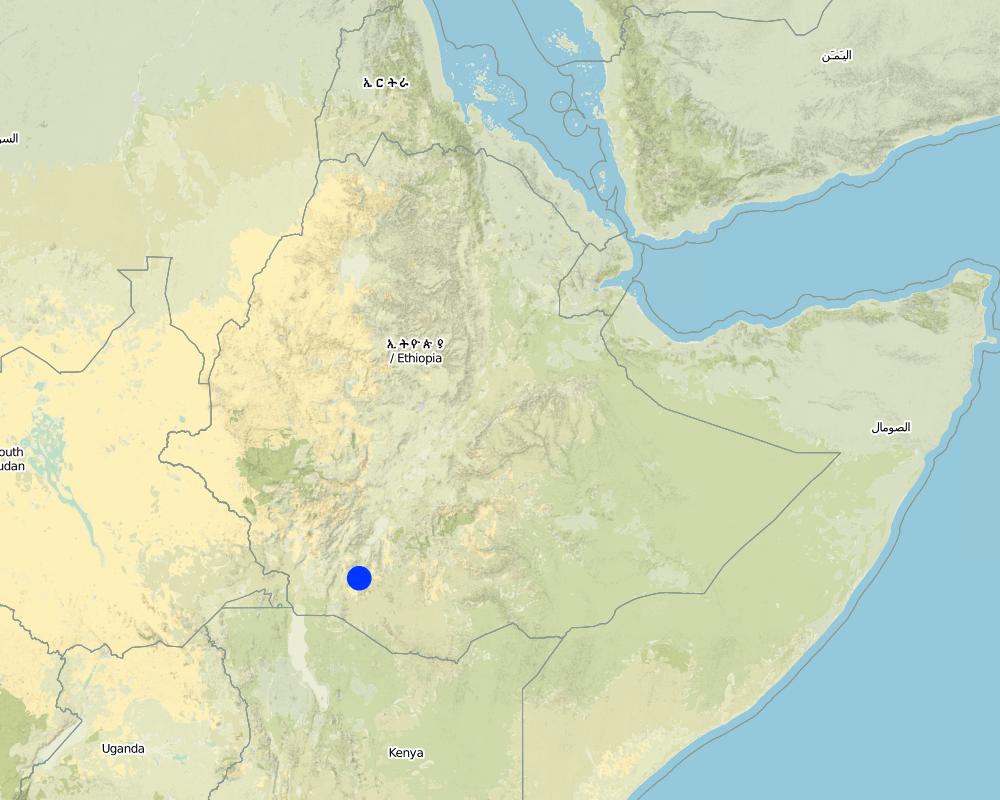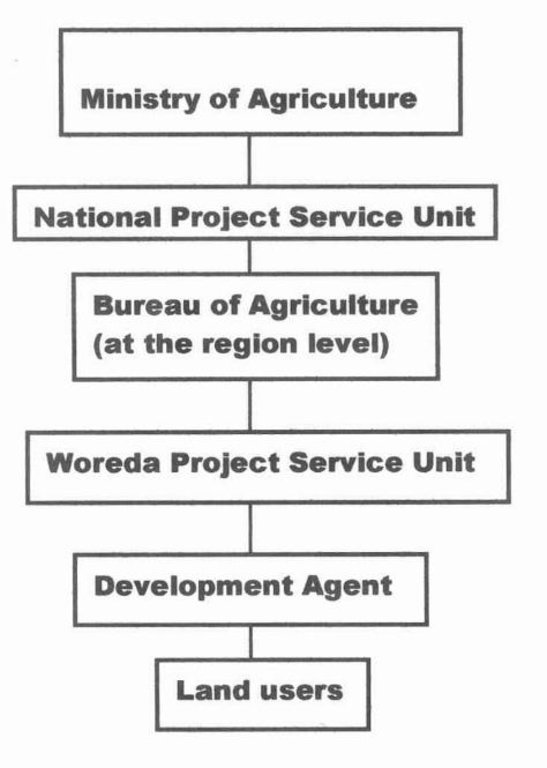Local Level Participatory Planning Approach (LLPPA) [埃塞俄比亚]
- 创建:
- 更新:
- 编制者: Philippe Zahner
- 编辑者: –
- 审查者: Fabian Ottiger
approaches_2389 - 埃塞俄比亚
查看章节
全部展开 全部收起1. 一般信息
1.2 参与方法评估和文件编制的资源人员和机构的联系方式
有助于对方法进行记录/评估的机构名称(如相关)
Swiss Agency for Development and Cooperation (DEZA / COSUDE / DDC / SDC) - 瑞士1.3 关于使用通过WOCAT记录的数据的条件
编制者和关键资源人员接受有关使用通过WOCAT记录数据的条件。:
是
1.4 SLM技术问卷的参考

Terrasses en banquettes Konso [埃塞俄比亚]
Un talus en pierres selon les courbes du niveau en nivelant progressivement la terre entre deux niveaux afin de contrôler l'érosion du sol.
- 编制者: Daniel Danano
2. SLM方法的描述
2.1 该方法的简要说明
It is food for work based participatory approach, by which the land users takes part in all stages of conservation planning, implementation and evaluation.
2.2 该方法的详细说明
该方法的详细说明:
Aims / objectives: The overall purpose of the approach is to achieve better SWC through promotion of participation, Awarness creation, better organization and better planning. The specific objective of the approach is to provide solutions for Top down approach, to achieve better quality work, to achieve better participation, to achieve better planning, implementation, monitoring and evaluation.
Methods: There are different methods involved in the approach, to mention some: Wealth ranking, Vulnerability assessment and mapping.
Stages of implementation: The stages of implementations are planning, implenentation, monitoring and evaluation.
Role of stakeholders: The roles of the participants are sharing their views and opinions on the resources management and they contribute the full labour required for the activities.
2.3 该方法的照片
2.5 采用该方法的国家/地区/地点
国家:
埃塞俄比亚
区域/州/省:
SNNPR
Map
×2.6 该方法的开始和终止日期
注明开始年份:
1978
2.7 方法的类型
- 基于项目/方案
2.8 该方法的主要目的/目标
The Approach focused on SLM only
Facilitate better achievments of SWC through promotion of participation, awarness creation, better organization, training skill upgrading and better planing
The SLM Approach addressed the following problems: Topdown approach, poor participation and integration, poor planning, low quality of conservation activities and low level of awareness
2.9 推动或妨碍实施本办法所适用的技术的条件
社会/文化/宗教规范和价值观
- 阻碍
Low level of awarness, cultural taboos and poor participation (especially for women)
Treatment through the SLM Approach: Awarness creation activities have been promoted using different methods
财务资源和服务的可用性/可得性
- 阻碍
Lack of budget (for ttraining and petty cash)
Treatment through the SLM Approach: By project funding and through income generating activities
机构设置
- 阻碍
Office and staff shortage
Treatment through the SLM Approach: Enough staff should be recurited and offices should be constructed
法律框架(土地使用权、土地和水使用权)
- 阻碍
Absence of policies on the appropraite use of natural resources
Treatment through the SLM Approach: Proper polcy formulation
了解SLM,获得技术支持
- 阻碍
Shortage of skilled manpower and absence of educated farmer
Treatment through the SLM Approach: Short and long term training
3. 相关利益相关者的参与和角色
3.1 该方法涉及的利益相关者及其职责
- 当地土地使用者/当地社区
Working land users were mainly men (The conservation activities like Bench Terraces are considered heavly and labourious and mainly done by men whereas nursery activities are equally divided)
Local traditional men are considered as hard worker and labourious SWC activities are mainly done by men. Tedious works like bench terraces, ridge and basin etc. are mainly done by men. Less tedious activities like pitting, potting and planting are done by women and men equally. Farmers with very small land holdings participate during general LLPPA meetings
- 国家政府(规划者、决策者)
Ministry of Agriculture
- 国际组织
WFP (World Food Programme)
如果涉及多个利益相关者,请注明领导机构:
The National and international SWC specialists together modified the minimum planning approach to LLPPA
3.2 当地土地使用者/当地社区参与该方法的不同阶段
| 当地土地使用者/当地社区的参与 | 指定参与人员并描述活动 | |
|---|---|---|
| 启动/动机 | 互动 | Mainly:LLPPA; partly: public meetings |
| 计划 | 互动 | Mainly: LLPPA; partly: public meetings |
| 实施 | 外部支持 | responsibility for major steps |
| 监测/评估 | 无 | |
| Research | 无 |
3.3 流程图(如可用)
3.4 有关SLM技术选择的决策
具体说明谁有权决定选择要实施的技术:
- 主要是土地使用者,由SLM专家提供支持
解释:
consultative
Decisions on the method of implementing the SLM Technology were made by mainly by land users supported by SLM specialists. consultative
4. 技术支持、能力建设和知识管理
4.1 能力建设/培训
是否为土地使用者/其他利益相关者提供培训?:
是
明确受训人员:
- 土地使用者
- SWC specialists
培训形式:
- 在职
- 农民对农民
涵盖的主题:
Planning, skill upgrading and technical training on SWC
4.2 咨询服务
土地使用者有权使用咨询服务吗?:
是
指明是否提供了咨询服务:
- 在土地使用者的土地上
说明/注释:
1) Advisory service was carried out through: government's existing extension system; Extension staff: mainly government employees
Advisory service is inadequate to ensure the continuation of land conservation activities; in relation to SWC the extension is weak and it is crop biased
4.3 机构强化(组织发展)
是否通过这种方法建立或加强了机构?:
- 是,适度
具体说明机构的强化或建立程度:
- 本地
具体说明支持类型:
- 财务
- 能力建设/培训
- 设备
4.4 监测和评估
监测和评估是该方法的一部分吗?:
是
注释:
bio-physical aspects were ad hoc monitored through observations
technical aspects were regular monitored through measurements
socio-cultural aspects were ad hoc monitored through observations
area treated aspects were monitored through observations
no. of land users involved aspects were monitored through measurements
There were several changes in the Approach as a result of monitoring and evaluation: As a result of monitoring and evaluation the quality of work improved. Exotic SWC techniques which fits to the local conditions has been incorporated.
5. 融资和外部物质支持
5.1 该方法中SLM组成部分的年度预算
注释(例如主要的资助来源/主要捐助者):
Approach costs were met by the following donors: international (UN-FFW Ethiopia): 70.0%; government (national Ethiopian Government): 30.0%
5.2 为土地使用者提供财政/物质支援
土地使用者是否获得实施该技术的财政/物质支持?:
是
5.3 对特定投入的补贴(包括劳动力)
- 设备
| 具体说明哪些投入得到了补贴 | 程度如何 | 对补贴做出具体说明 |
|---|---|---|
| 工具 | 部分融资 | Hand tools |
- 农业
| 具体说明哪些投入得到了补贴 | 程度如何 | 对补贴做出具体说明 |
|---|---|---|
| 种子 | 部分融资 | |
如果土地使用者的劳动力是一项重要的投入,那么是不是:
- 以粮换工
5.4 信用
是否根据SLM活动的方法给予信用值?:
否
6. 影响分析和结论性陈述
6.1 方法的影响
该方法是否帮助土地使用者实施和维护SLM技术?:
- 否
- 是,很少
- 是,中等
- 是,支持力度很大
modified the traditional one to fit into the modern ones.
该方法是否改善了阻碍SLM技术实施的土地使用权/用户权问题?:
- 否
- 是,很少
- 是,中等
- 是,支持力度很大
Did other land users / projects adopt the Approach?
- 否
- 是,很少
- 是,中等
- 是,支持力度很大
6.3 方法活动的可持续性
土地使用者能否维持通过该方法实施的措施(无外部支持的情况下)?:
- 不确定
6.4 该方法的长处/优点
| 土地使用者眼中的长处/优势/机会 |
|---|
| Better acess to decision making (How to sustain/ enhance this strength: By empowering) |
| Skill upgrading (How to sustain/ enhance this strength: more training) |
| FFW incentive |
| 编制者或其他关键资源人员认为的长处/优势/机会 |
|---|
| Participatory nature (How to sustain/ enhance this strength: By further empowering the local community) |
| Capacity builiding efforts (How to sustain/ enhance this strength: By giving more training and skill upgrading) |
| Awarness raising (How to sustain/ enhance this strength: By giving more training and skill upgrading) |
6.5 该方法的弱点/缺点以及克服它们的方法
| 编制者或其他关键资源人员认为的弱点/缺点/风险 | 如何克服它们? |
|---|---|
| FFW orientation | Gradually decreasing the food aid by increasing the productivity and self help activities |
7. 参考和链接
7.1 方法/信息来源
- 实地考察、实地调查
- 与土地使用者的访谈
链接和模块
全部展开 全部收起链接

Terrasses en banquettes Konso [埃塞俄比亚]
Un talus en pierres selon les courbes du niveau en nivelant progressivement la terre entre deux niveaux afin de contrôler l'érosion du sol.
- 编制者: Daniel Danano
模块
无模块


